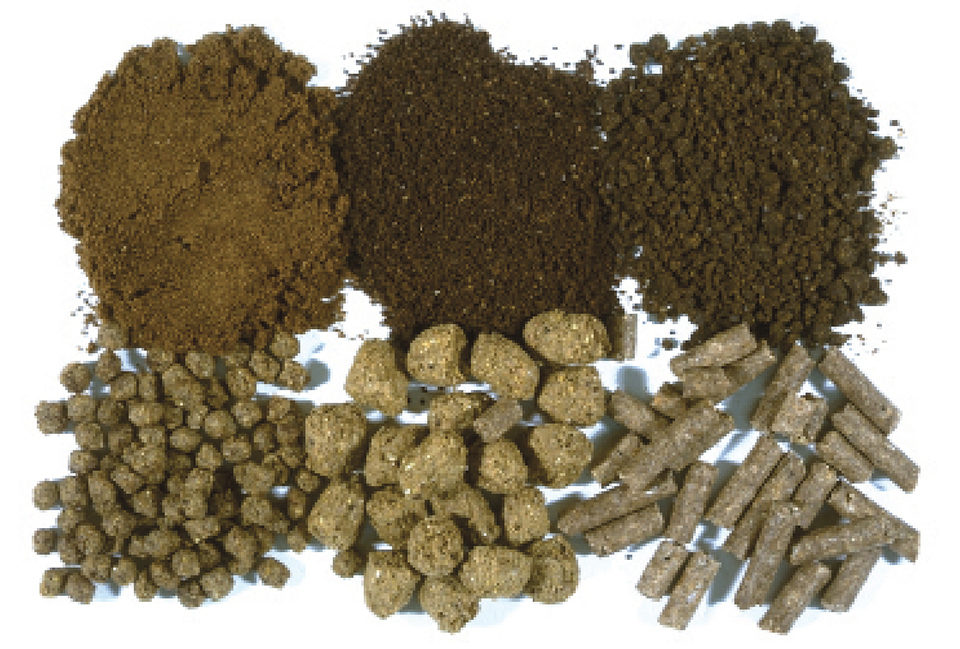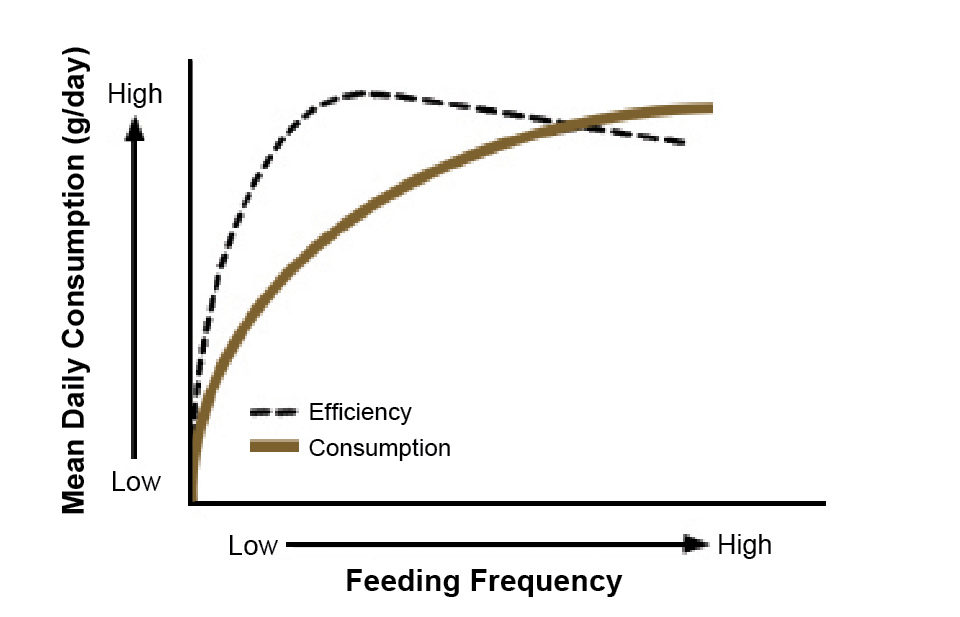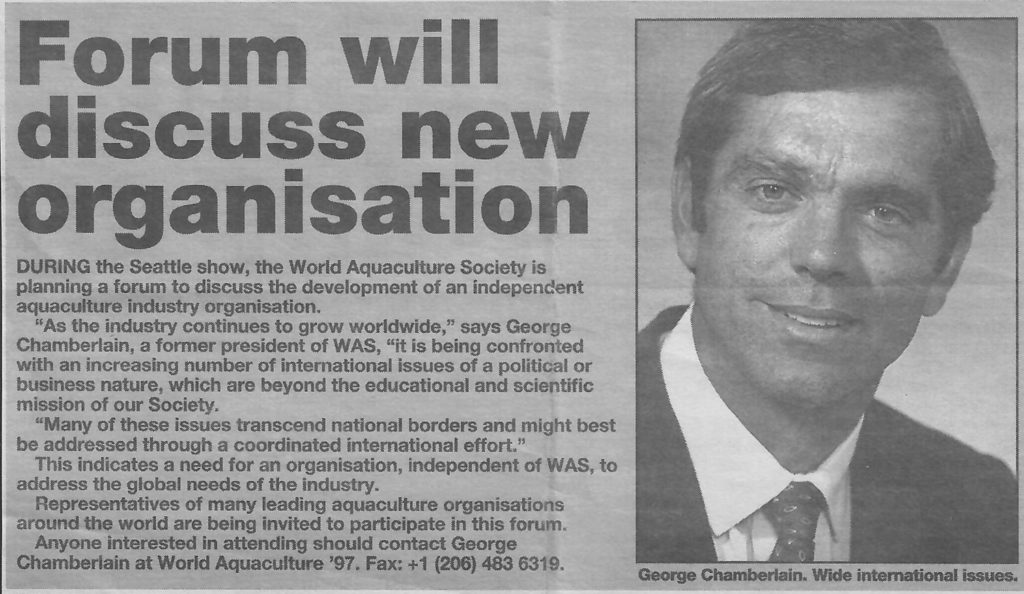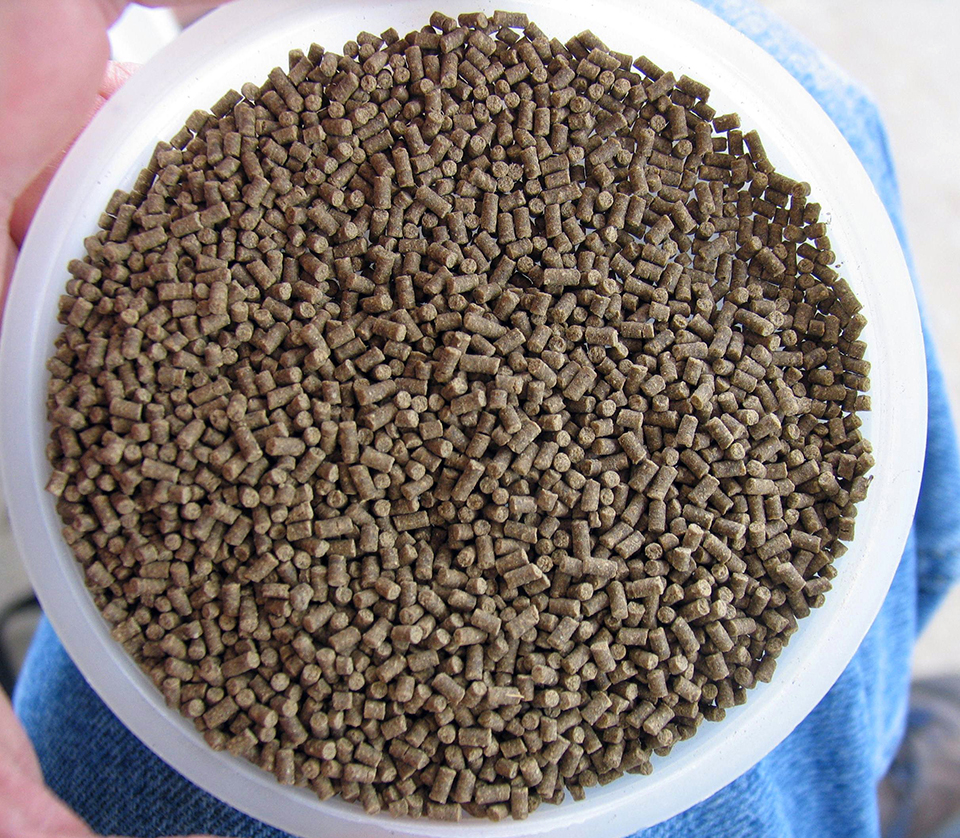Knowing when and how to feed is as important as knowing what to feed

Nutrition is at the hub of successful farming operations, but its importance is often overlooked or underappreciated. Nutrition is generally thought of as simply meeting the nutrient requirements of the culture species, but this misses the broader significance of nutrition.
The roles feed manufacturing and feed management strategies play are often taken for granted. Also often under-appreciated is the importance of integrating nutrition into the planning stages of aquaculture operations. Nutrition affects and in turn is affected by the other considerations of the aquaculture facilities.
Feed quality and composition directly affect rate of growth, product quality, and time to market. Management of both the animals and farm personnel are dictated by the type of feed and feeding frequency, as well as the timing and method of feed delivery. Dietary composition, energy density, and appropriate feeding rates that meet animals requirements directly affect growth, health, feed efficiency and ultimately the bottom line. Therefore, a successful feeding strategy is important for success.
Species-specific strategies
The first step toward success is to have a complete understanding of the species being fed and the constraints it faces, the significance of which is generally underappreciated. Even two species that have the same nutritional requirements under optimal conditions will respond to stressors and changing environmental conditions differently.
The effects on feed intake, growth, and efficiency differ in response to fluctuations in temperature, dissolved oxygen, and water quality. The severity and duration of these affects can even differ within the same species depending on prior acclimation history. Other factors such as density, age of maturation, health status, and the perceived presence of humans or predators can result in different responses in feeding behavior, growth, and efficiency.
Most important, however, is an understanding of how size and growth rate affect feed intake, protein, and energy requirements. All these factors help define what you are feeding and what and how the animals should be fed.
What to feed
Like their terrestrial counterparts, aquatic animals require protein, fats, vitamins, and minerals to support growth and stay healthy. They are dependent on feed – whether natural or manufactured – to supply essential nutrients and energy.
Although species differ in the nature and quantity of their essential nutrient requirements, all aquatic animals require the same 10 essential amino acids, which are usually ingested in the form of protein. Feed can represent 50 percent or more of production costs, and since protein is the most expensive component of feeds, it is important to use highly digestible feeds that closely match the essential amino acid requirements of the target animal. However, the amino acids must also be available to the animal in the right balance at the right time.
Energy density
The amount of energy in diets, or energy density, is also an important consideration. A recent trend in fish farming is to use feeds that contain higher levels of fat so less protein is used for energy, making more protein available for growth. However, high-energy diets can reduce the amount of feed consumed.
High-energy diets require that other nutrients be incorporated at higher levels to ensure sufficient quantities are consumed to meet the animals’ needs. Thoughtful consideration should be given to the use of high-energy diets because they can increase the amount of fat in fish, which can lead to rancidity and reduce shelf life.
Aquafeed selection
An appropriate feed pellet size is also important. Pellet size should increase with the size of the fish. Too-small pellets increase feed waste and increase energy expenditure to obtain feed, both of which decrease feed efficiency. Pellets that are too large may not be eaten, or feed can be wasted as fish break it up to swallow it, again decreasing feed efficiency. When faced with varied animal size, it is best to use a size appropriate for the smaller fish to ensure everyone can eat.
Pellet size, shape, color, and palatability all influence intake and hence growth. Pellet hardness, stability, and water content also affect intake, digestion, and nutrient availability. Feeds with high amounts of fine particles should be avoided, as the particles are largely unavailable to the fish and can degrade water quality.
Another consideration is whether to use sinking or floating feeds. Floating feed allows observation of fish feeding behavior and activity. If too little or too much feed is offered, this allows feed rates to be adjusted accordingly. However, some species prefer to feed from the water column or off the bottom. Floating feeds are made through the extrusion process during feed manufacturing. In addition to their benefit of observation, the extrusion process cooks the dietary starch, making the carbohydrate more available.
When to feed
Knowing when and how to feed is as important in developing a feeding management strategy as knowing what to feed. The number of daily feedings and feeding frequency both affect feed intake and efficiency.
In general, most species show increased daily consumption with an increased number of feedings, until a plateau is reached (Fig. 1). Consumption near this plateau is associated with increased growth, but comes at the expense of efficiency. It is up to farm managers to determine an appropriate compromise.

Increasing the frequency of feedings allows more meals to be offered in a day, but feeding before appetite has returned reduces digestion efficiency, resulting in more solids production and reduced feed efficiency. In addition, it increases labor costs associated with feeding – again requiring a trade-off.
Seasons, times of day
Changing seasons and day length are also important considerations. Alternative diets or feeding strategies that compensate for lower water temperatures in winter and higher temperatures in summer are essential. Similarly, feed rates or dietary composition may need to change to maximize spawning results.
Feeding schedules that account for animals’ natural feeding rhythms increase intake and efficiency. However, during warm seasons, low dissolved oxygen levels can require that fish skip a morning meal even if it is their preferred feeding time. Most farm managers only feed during daylight hours, but some choose a 24-hour feeding schedule to increase daily intake. However, this usually comes at the expense of efficiency.
Rearing systems
The type of rearing system frames an appropriate feeding management strategy. Farmers using net pens, cages, and ponds generally have less control over temperature and other environmental parameters than those who run recirculating systems. This may necessitate more frequent monitoring of feed rates. Reduction of feed rates or switching to a seasonal feed may be in order.
Farms utilizing ponds may choose to feed once a day or use supplemental feeding to take advantage of natural feeds. Conversely, fish in recirculating systems do not have access to natural feeds and require a complete and balanced diet.
Fish in cages or net pens may require slow-sinking feeds or a mechanism for delivering feed that allows access to feed before it is out of reach. Farm managers who employ supplemental aeration or oxygenation may be able to increase feed intake by increasing feed rates or feeding frequencies.
(Editor’s Note: This article was originally published in the November/December 2007 print edition of the Global Aquaculture Advocate.)
Now that you've reached the end of the article ...
… please consider supporting GSA’s mission to advance responsible seafood practices through education, advocacy and third-party assurances. The Advocate aims to document the evolution of responsible seafood practices and share the expansive knowledge of our vast network of contributors.
By becoming a Global Seafood Alliance member, you’re ensuring that all of the pre-competitive work we do through member benefits, resources and events can continue. Individual membership costs just $50 a year.
Not a GSA member? Join us.
Authors
-
Marty Riche, Ph.D.
United States Department of Agriculture
Agricultural Research Service
Harbor Branch Oceanographic Institute
5600 U.S. Highway 1 North
Fort Pierce, Florida 34946 USA[118,111,103,46,97,100,115,117,46,115,114,97,64,101,104,99,105,114,46,121,116,114,97,109]
-
Tagged With
Related Posts

Health & Welfare
10 paths to low productivity and profitability with tilapia in sub-Saharan Africa
Tilapia culture in sub-Saharan Africa suffers from low productivity and profitability. A comprehensive management approach is needed to address the root causes.

Innovation & Investment
20 years of the Global Aquaculture Alliance
A timeline of key milestones and achievements by the Global Aquaculture Alliance and its third-party aquaculture certification scheme, Best Aquaculture Practices (BAP).

Health & Welfare
A case for better shrimp nutrition
Shrimp farm performance can often be below realistic production standards. Use proven nutrition, feeds and feeding techniques to improve profitability.

Health & Welfare
A holistic management approach to EMS
Early Mortality Syndrome has devastated farmed shrimp in Asia and Latin America. With better understanding of the pathogen and the development and improvement of novel strategies, shrimp farmers are now able to better manage the disease.


